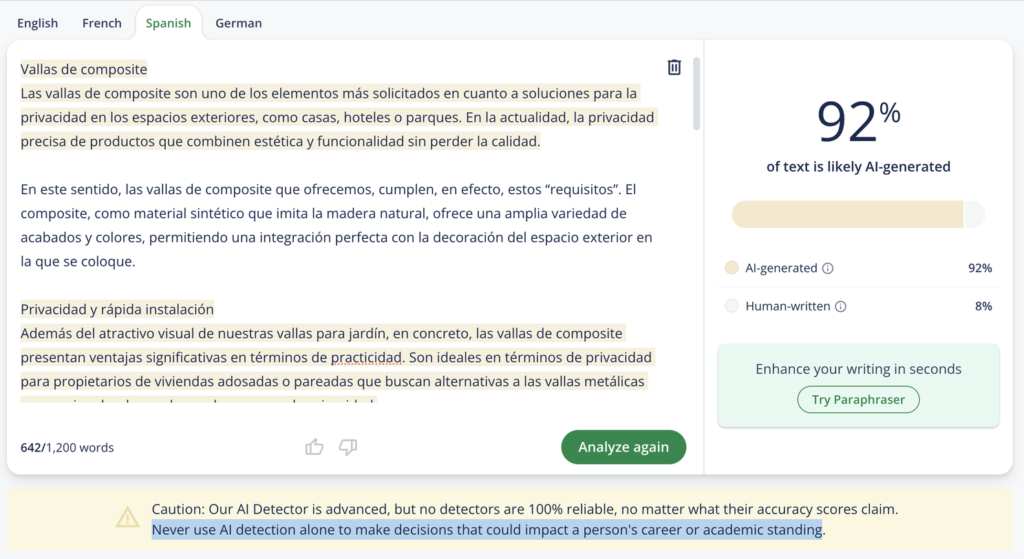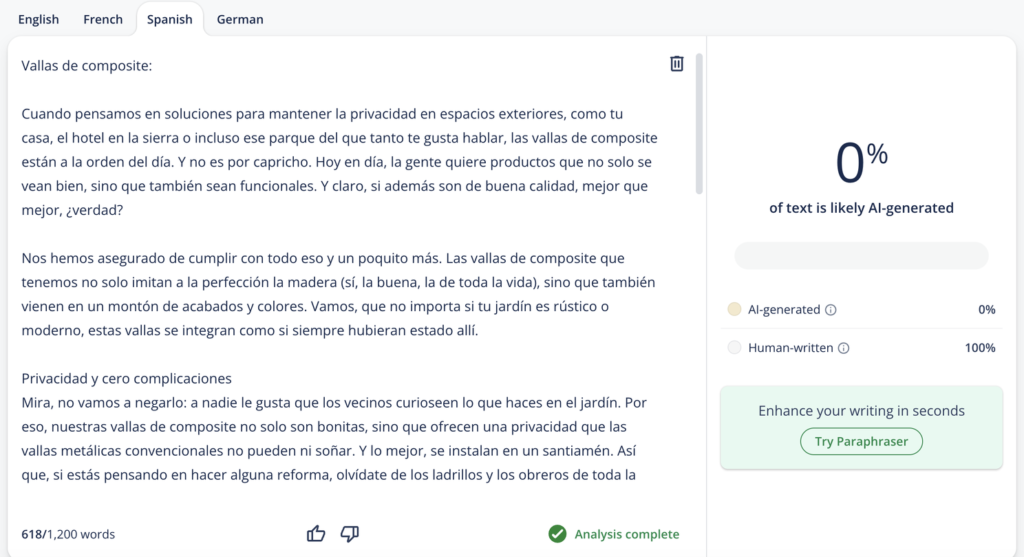Given the confusion around what it really means for a text to be labeled as “AI-generated,” I’d like to clear a few things up.
The tools that detect AI-generated content look at linguistic and stylistic patterns typical of automated language models. Below, I’ll point out some common differences between texts written by humans and those churned out by AI:
- Uniform structure and coherence: AI-generated texts usually have a very organized and coherent structure, sometimes too perfect. On the other hand, humans tend to show variations in the flow of their writing, with digressions or shifts in tone that add a bit of flavor.
- Repetition of phrases and constructions: It’s common for AI to repeat certain phrases, terms, or sentence structures, which can make the writing feel a bit redundant. Human writers, though, usually mix up their vocabulary and style, keeping the reader more engaged.
- Limited use of idioms and colloquialisms: AI-generated texts tend to lack idioms, sayings, or folksy expressions, which are more common in human language. This can make the text sound a little generic or impersonal.
- Absence of typos or grammar mistakes: While human writers might make the occasional spelling or grammar slip, AI-generated texts are typically free of those kinds of mistakes, which can be a tell-tale sign for detection tools.
- Neutral and objective tone: AI-written texts often maintain a steady, neutral tone without much emotion or personal opinion. Human writers, however, are more likely to add feelings, humor, or even a bit of sarcasm to liven things up.
- Personal details and anecdotes: Humans can throw in personal experiences, anecdotes, or specific details that add some richness to the text. AI, lacking life experiences, can’t quite pull off that kind of depth.
Detection tools aren’t perfect: It’s worth keeping in mind that these AI detection tools aren’t foolproof. For example, tools like quillbot.com even warn that the results they provide when identifying AI-generated texts might not always be spot-on.
Caution: Our AI Detector is advanced, but no detectors are 100% reliable, no matter what their accuracy scores claim. Never use AI detection alone to make decisions that could impact a person’s career or academic standing.
There are a few more things y’all might wanna keep in mind:
Switch up your sentence structure: Try mixin’ short and long sentences to create a more natural rhythm. This can make the text feel less robotic and more like it came from a real person.
Incorporate personal experiences or examples: Throwin’ in anecdotes or specific cases can give the text a more authentic, personal feel. Folks like hearing real-life stories.
Use colloquial language or idiomatic expressions: Tossin’ in common phrases, sayings, or idioms adds warmth and makes the text feel more down-to-earth.
Mind your tone and voice: Make sure the tone fits the audience. If it’s too neutral or stiff, it might come off like it was written by AI. Keep it conversational and friendly, like you’re talkin’ to a neighbor.
Avoid excessive repetition: Look over the text to cut out any redundant phrases or ideas. Repetition’s a dead giveaway that something’s off, and AI detection tools are quick to pick up on it.
Add rhetorical questions or engage with the reader: This can make the text more lively and build a connection with the reader. Askin’ questions like, “Ain’t that somethin’?” or “Y’all know what I mean?” keeps things personal.
Include specific details and data: Providing figures, stats, or solid references adds depth and shows you really know what you’re talkin’ about.
Use varied transitions and connectors: Words like “however,” “on the other hand,” or “besides that” can help the flow of the text and make it sound more natural.
Show emotions and opinions: Throwin’ in a bit of personal feelin’ or perspective makes the content more human, helping it stand apart from AI-generated text.
Carefully revise and edit: A good ol’ thorough review will help spot any parts of the text that feel a bit too stiff or artificial, and you can tweak ‘em so they sound more natural.
And how do you go from 92% to 0%?
Well, I gotta admit, I didn’t come up with this on my own (GPT lent me a hand), but I’ve crafted a prompt that takes a text from 92% down to 0%.

Now, for this other thing:

Anti-AI Prompt: Copy and Paste
Take the following text and rewrite it, keeping these guidelines in mind to make it feel more human and genuine:
- Switch up the sentence structure and flow: Make sure it doesn’t sound too rigid or repetitive. Mix it up a little.
- Diversify the vocabulary and style: Don’t stick to the same ol’ words.
- Throw in some idiomatic expressions and colloquialisms: Keep it real with some down-home phrases.
- Add minor typos or grammatical quirks: It’s those tiny mistakes that remind folks a human’s behind the screen.
- Sprinkle in some emotion, humor, or sarcasm (when it makes sense): Make it lively, not robotic.
- Use a personal voice: Write it like you’re talking to someone, not giving a lecture.
- Add specific details and data (if they’re in the original text): A few numbers or examples can go a long way.
- Use a variety of transitions and connectors: Smooth out the flow with things like “but,” “besides,” or “on the flip side.”
Original text to rewrite:
Insert the original text right here: “ORIGINAL TEXT.”
Clarifications:
Just because a text scores high on an AI detection test doesn’t mean a real human didn’t review or have a hand in crafting it. Hope that clears things up a bit.
Google? Well, it’s basically a big ol’ math machine that crunches through text with algorithms… Just sayin’.